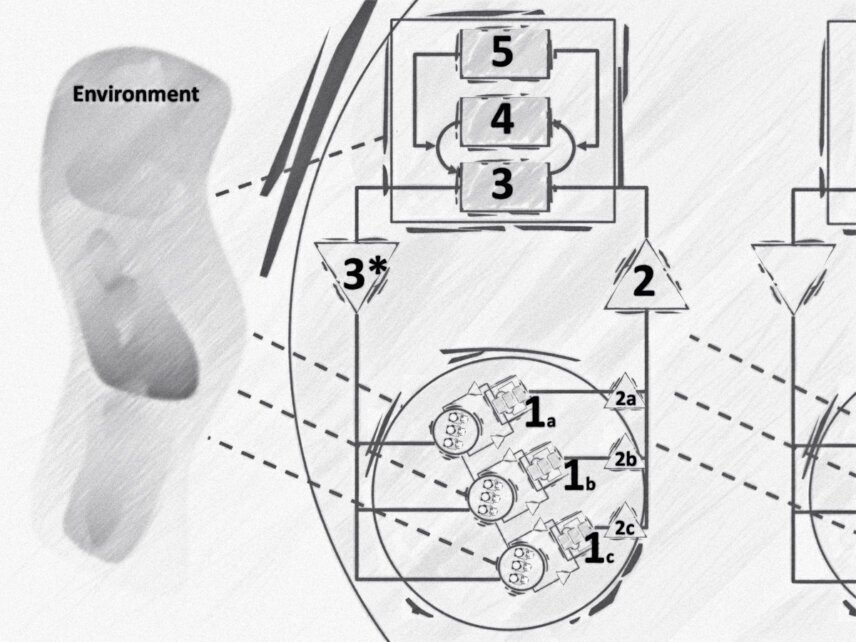Viable System Model
Over
time, distributing work among several employees has made it possible to
introduce simpler tasks. Increased productivity allows higher quantities to be
produced more economically. It comes at the expense of opaque business models,
monotonous work, long reporting and decision-making processes, and, above all,
reduced adaptability. Artificial intelligence is not a way out, as business
models can no longer be controlled. The solution lies in returning to the
holistic bundling of work that delivers self-organizing, executable components.
In addition to approaches such as holocracy, platforms, agility, and networked
enterprises, VSM offers a proven alternative. The disadvantages of fragmenting
work can be replaced by regrouping tasks with all the mechanisms of
coordination.

The Viable System Model (VSM) shows how organizations remain viable through independently interacting work groups. Instead of separating control and execution and breaking tasks down into mindless tasks, it relies on autonomous structures that deliver independently functional results. It consists of five systems that can be combined into larger units that are structured identically.
- System 1 – Value creation (S1)
In area S1, subsystems (S1a) generate their services. Those responsible for manufacturing the products in a self-organized manner or performing the services. There are interfaces to the environment, for example, to customers, suppliers, and partners. It is where value-adding activities take place. Each of these working groups is a VSM in its own right. In the language of the new approaches, these would be the sub-circles, the producers, the agile teams, or the pods. - System 2 – Harmonization (S2)In order to compensate deviations within and between the operational units (1a-1c), it is necessary to coordinate inside (2a-2c) and cross-operationally (2) regarding range, functionality and interfaces. The vague exchange within the framework of the new approaches is handled in the VSM in subsystem S2. Cooperation is based on rules, schedules, and regular exchanges.
- System 3 – Coordination (S3)
Even if the interaction in S2 is harmonized, everyone must continue to consider the big picture. To this end, system S3 distributes the resources and roles to be used, makes decisions, and disseminates guidelines in the operational areas. In addition to S3, the independent team S3* collects information that accurately reflects the current state of affairs – comparable to an audit. The new approaches use, for example, backlog refinements and daily scrums, interaction platforms, and governance for coordination. - System 4 – Alignment (S4)
To harmonize the teams, System S4 updates the strategy. This alignment is influenced by general factors – political, economic, social, technological, legal, and ecological. Stakeholders should develop the course together to minimize resistance from the outset. The strategy and, subsequently, the planning are based on innovative insights, including the development of the (executing) personnel. The new approaches happen on-site. - System 5 – Last resort (S5)
The areas of tension between the present (S3) and the future (S4), and between the company and the environment, are not resolved in systems 1–4. The highest authority is the self-image, the business model, and the raison d'être, which prevent the subsystems from hindering each other due to different internal interests and damaging the overall result. The new approaches build on the natural resolution of discrepancies through transparency and open exchange of positions.
Conclusion: Companies have no choice but to reposition themselves to fulfill their purpose in today's VUCA world. The division of jobs, which ultimately creates henchmen at the bottom of the pyramid who perform simple tasks without thinking, is no longer justified. The large number of decision-makers makes them too complex, too slow, and too inflexible, and they lose their customer focus. Machines and robots can now perform the old "simple" processes. The cascades of reporting and decision-making channels are also becoming redundant thanks to the general availability of data on the World Wide Corporate Net. You have no choice but to restructure your own company to remain viable for the future. VSM promotes the systematic assignment of roles (tasks, competencies, and responsibilities) to a single person at the point of action. In addition, rigid companies are revitalized through the dismantling of entrenched bureaucracy.

